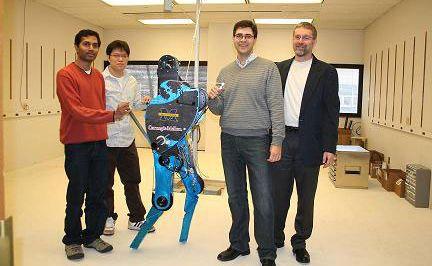Robots learn how to run
A ROBOT in a University of Michigan lab can run like a human, a feat that represents the height of agility and efficiency for a two-legged machine.

Business
Don't miss out on the headlines from Business. Followed categories will be added to My News.
A ROBOT in a University of Michigan lab can run like a human, a feat that represents the height of agility and efficiency for a two-legged machine.
With a peak pace of almost 11 kilometers per hour, MABEL is believed to be the world's fastest bipedal robot with knees.
"It's stunning," said Jessy Grizzle, a professor in the Department of Electrical Engineering and Computer Science.
"I have never seen a machine doing a motion like this."
While our fascination with robots has been historically focused on military applications, robots have proven useful in areas such as medicine and food production as well.
"The robotics community has been trying to come up with machines that can go places where humans can go, so a human morphology is important," Grizzle said.
"If you would like to send in robots to search for people when a house is on fire, it probably needs to be able to go up and down stairs, step over the baby's toys on the floor, and maneuver in an environment where wheels and tracks may not be appropriate."
MABEL was built in 2008 in collaboration with Jonathan Hurst, who was then a doctoral student at the Robotics Institute at Carnegie Mellon University. Grizzle and U-M doctoral students Koushil Sreenath and Hae-Won Park have spent the years since ratcheting up MABEL's training. They've been progressively improving the feedback algorithms that enable the robot to keep its balance while reacting to its environment in real time.
Few robots can run, and the researchers say no machine but MABEL can do it with such a human-like gait.
"We envision some extraordinary potential applications for legged robot research: exoskeletons that enable wheelchair-bound people to walk again or that give rescuers super-human abilities, and powered prosthetic limbs that behave like their biological counterparts," said developer Hurst, who is now an assistant professor in the Department of Mechanical, Industrial and Manufacturing Engineering at Oregon State University.
Two-legged robots with good running form would also have the advantage of being able to travel over rough terrain and inside places built for humans. They could one-day serve as robotic soldiers or rescuers, the engineers say.
Wheels are a great way to move across flat surfaces, Sreenath said, but when the ground gets rocky, two legs are much more efficient.
"Imagine a future where you don't have to first clear a path and build roads before a vehicle could move around.
"But rather, we have a class of running machines like animals that could transport you around with no roads, but with a smooth and efficient ride," Sreenath said.
Watch MABEL run. The bar it's attached to merely guides it to move in a circle. You'll see it speed up and then abruptly slow down several times. Its controller does this on purpose.
Originally published as Robots learn how to run


